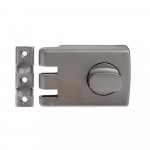Packard
Member
This is simply a hypothetical and theoretical exercise.
I am reading an entertaining novel about the United States Marshalls’ Service. In that book they are getting ready to breach an entryway door in an apartment.
There was a surprising statement that they hoped that it was not a hollow core door. Solid core doors were much easier to breach.
They used a breaching ram. Two man breaching rams are typically 40 - 50 pounds and about 36” long by about 5” in diameter.
The theory put forth in the book, was that a hollow core door was so weak that you ended up making a bunch of 5” diameter holes in the door without ever breaking open the door.
I suppose, if you make enough holes, you can eventually simply walk through the enlarged opening that they make. But keep in mind that the breaching ram wants to make the impact at a fairly specific height. It would be difficult to use it to make a hole at, for example, 4 feet high.
The solid core door is substantial enough that the breaching ram’s force would be transferred to the locking mechanism and the door would open instantly.
So, my thought is that the perimeter of the hollow core door be made from 2” x 1/8” steel and the lock set be mounted to that steel frame. Likewise the hinges.
I am undecided if there should be some sort metal grid to eliminate the aforementioned enlarged hole from multiple strikes. I am thinking 3/16” wire in a 12” x 12” grid pattern. Or perhaps just vertically on that same 12” spacing.
I find this an amusing mental exercise. Less amusing is that sold core doors are sometimes more vulnerable than hollow core doors.
I am reading an entertaining novel about the United States Marshalls’ Service. In that book they are getting ready to breach an entryway door in an apartment.
There was a surprising statement that they hoped that it was not a hollow core door. Solid core doors were much easier to breach.
They used a breaching ram. Two man breaching rams are typically 40 - 50 pounds and about 36” long by about 5” in diameter.
The theory put forth in the book, was that a hollow core door was so weak that you ended up making a bunch of 5” diameter holes in the door without ever breaking open the door.
I suppose, if you make enough holes, you can eventually simply walk through the enlarged opening that they make. But keep in mind that the breaching ram wants to make the impact at a fairly specific height. It would be difficult to use it to make a hole at, for example, 4 feet high.
The solid core door is substantial enough that the breaching ram’s force would be transferred to the locking mechanism and the door would open instantly.
So, my thought is that the perimeter of the hollow core door be made from 2” x 1/8” steel and the lock set be mounted to that steel frame. Likewise the hinges.
I am undecided if there should be some sort metal grid to eliminate the aforementioned enlarged hole from multiple strikes. I am thinking 3/16” wire in a 12” x 12” grid pattern. Or perhaps just vertically on that same 12” spacing.
I find this an amusing mental exercise. Less amusing is that sold core doors are sometimes more vulnerable than hollow core doors.



